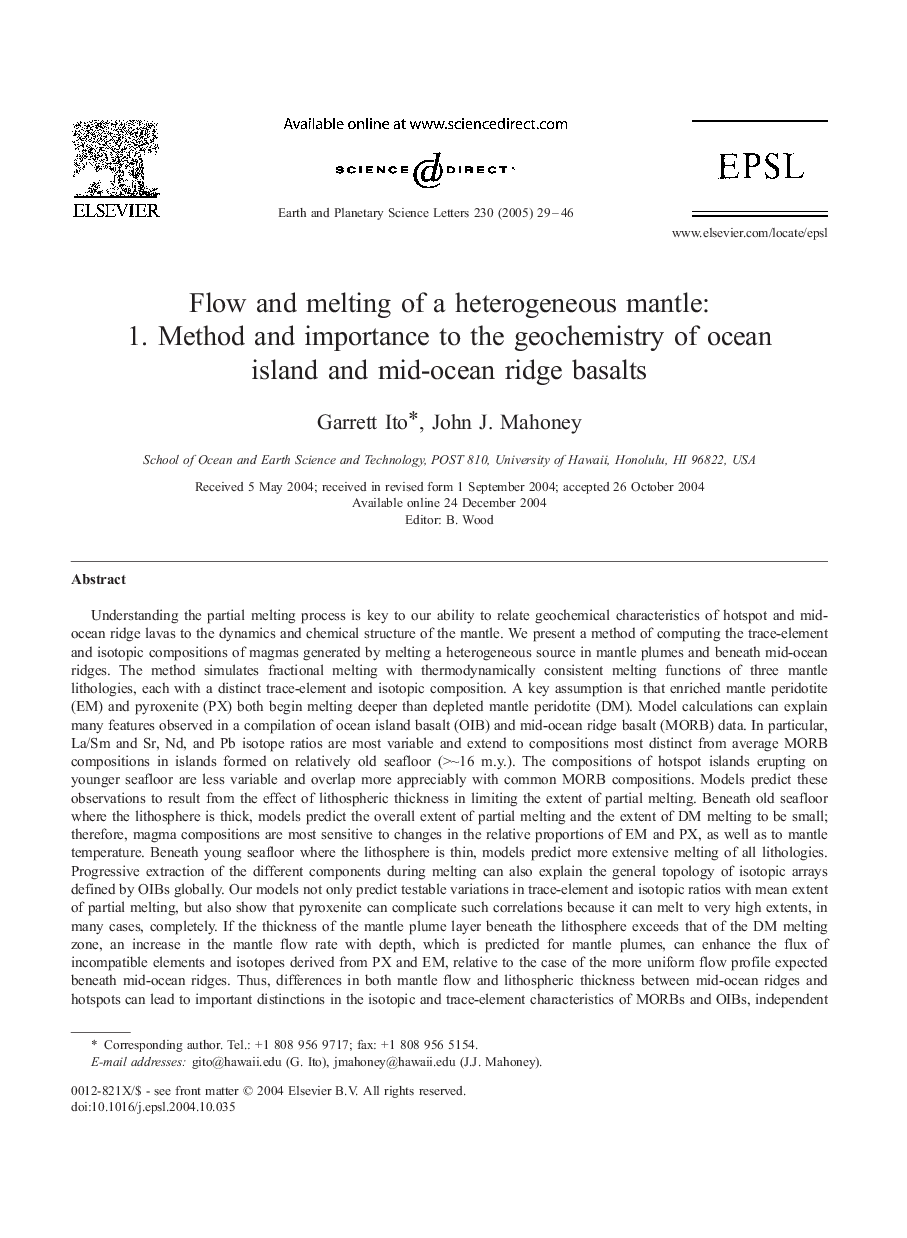| کد مقاله | کد نشریه | سال انتشار | مقاله انگلیسی | نسخه تمام متن |
|---|---|---|---|---|
| 9522527 | 1634974 | 2005 | 18 صفحه PDF | دانلود رایگان |
عنوان انگلیسی مقاله ISI
Flow and melting of a heterogeneous mantle: 1. Method and importance to the geochemistry of ocean island and mid-ocean ridge basalts
دانلود مقاله + سفارش ترجمه
دانلود مقاله ISI انگلیسی
رایگان برای ایرانیان
کلمات کلیدی
موضوعات مرتبط
مهندسی و علوم پایه
علوم زمین و سیارات
علوم زمین و سیاره ای (عمومی)
پیش نمایش صفحه اول مقاله

چکیده انگلیسی
Understanding the partial melting process is key to our ability to relate geochemical characteristics of hotspot and mid-ocean ridge lavas to the dynamics and chemical structure of the mantle. We present a method of computing the trace-element and isotopic compositions of magmas generated by melting a heterogeneous source in mantle plumes and beneath mid-ocean ridges. The method simulates fractional melting with thermodynamically consistent melting functions of three mantle lithologies, each with a distinct trace-element and isotopic composition. A key assumption is that enriched mantle peridotite (EM) and pyroxenite (PX) both begin melting deeper than depleted mantle peridotite (DM). Model calculations can explain many features observed in a compilation of ocean island basalt (OIB) and mid-ocean ridge basalt (MORB) data. In particular, La/Sm and Sr, Nd, and Pb isotope ratios are most variable and extend to compositions most distinct from average MORB compositions in islands formed on relatively old seafloor (>â¼16 m.y.). The compositions of hotspot islands erupting on younger seafloor are less variable and overlap more appreciably with common MORB compositions. Models predict these observations to result from the effect of lithospheric thickness in limiting the extent of partial melting. Beneath old seafloor where the lithosphere is thick, models predict the overall extent of partial melting and the extent of DM melting to be small; therefore, magma compositions are most sensitive to changes in the relative proportions of EM and PX, as well as to mantle temperature. Beneath young seafloor where the lithosphere is thin, models predict more extensive melting of all lithologies. Progressive extraction of the different components during melting can also explain the general topology of isotopic arrays defined by OIBs globally. Our models not only predict testable variations in trace-element and isotopic ratios with mean extent of partial melting, but also show that pyroxenite can complicate such correlations because it can melt to very high extents, in many cases, completely. If the thickness of the mantle plume layer beneath the lithosphere exceeds that of the DM melting zone, an increase in the mantle flow rate with depth, which is predicted for mantle plumes, can enhance the flux of incompatible elements and isotopes derived from PX and EM, relative to the case of the more uniform flow profile expected beneath mid-ocean ridges. Thus, differences in both mantle flow and lithospheric thickness between mid-ocean ridges and hotspots can lead to important distinctions in the isotopic and trace-element characteristics of MORBs and OIBs, independent of any compositional differences between their respective mantle sources. In addition, variations in mantle flow alone can contribute to geographic variations in hotspot geochemistry observed both in intraplate settings and where hotspots interact with mid-ocean ridges.
ناشر
Database: Elsevier - ScienceDirect (ساینس دایرکت)
Journal: Earth and Planetary Science Letters - Volume 230, Issues 1â2, 30 January 2005, Pages 29-46
Journal: Earth and Planetary Science Letters - Volume 230, Issues 1â2, 30 January 2005, Pages 29-46
نویسندگان
Garrett Ito, John J. Mahoney,